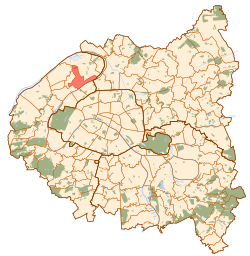Asnières-sur-Seine
Asnières-sur-Seine | |
|---|---|
 Château d'Asnières | |
 Paris and inner ring départements | |
| Country | France |
| Region | Île-de-France |
| Department | Hauts-de-Seine |
| Arrondissement | Nanterre |
| Government | |
| • Mayor (2014-2020) | Manuel Aeschlimann |
Area 1 | 4.82 km2 (1.86 sq mi) |
| Population (2012) | 83,845 |
| • Density | 17,000/km2 (45,000/sq mi) |
| Time zone | UTC+01:00 (CET) |
| • Summer (DST) | UTC+02:00 (CEST) |
| INSEE/Postal code | 92004 /92600 |
| Elevation | 22–43 m (72–141 ft) |
| 1 French Land Register data, which excludes lakes, ponds, glaciers > 1 km2 (0.386 sq mi or 247 acres) and river estuaries. | |
Asnières-sur-Seine (French pronunciation: [a.njɛʁ syʁ sɛn]) is a commune in the northwestern suburbs of Paris, France, along the river Seine. It is located 7.9 km (4.9 mi) from the center of Paris.
Name
Asnières-sur-Seine was originally called simply Asnières. Asnières was recorded for the first time in a papal bull of 1158 as Asnerias, from Medieval Latin asinaria, meaning "donkey farm". The poor soil of Asnières, where heather grew in Medieval times, was probably deemed only suitable for the breeding of donkeys.
On 15 February 1968 the commune was officially renamed Asnières-sur-Seine (meaning "Asnières upon Seine"), in order to distinguish it from other communes of France also called Asnières.

Demographics
Immigration
| Born in metropolitan France | Born outside metropolitan France | |||
|---|---|---|---|---|
| 78.3% | 21.7% | |||
| Born in overseas France |
Born in foreign countries with French citizenship at birth1 | EU-15 immigrants2 | Non-EU-15 immigrants | |
| 1.7% | 2.9% | 3.5% | 13.6% | |
| 1 This group is made up largely of former French settlers, such as pieds-noirs in Northwest Africa, followed by former colonial citizens who had French citizenship at birth (such as was often the case for the native elite in French colonies), as well as to a lesser extent foreign-born children of French expatriates. A foreign country is understood as a country not part of France in 1999, so a person born for example in 1950 in Algeria, when Algeria was an integral part of France, is nonetheless listed as a person born in a foreign country in French statistics. 2 An immigrant is a person born in a foreign country not having French citizenship at birth. An immigrant may have acquired French citizenship since moving to France, but is still considered an immigrant in French statistics. On the other hand, persons born in France with foreign citizenship (the children of immigrants) are not listed as immigrants. | ||||
Administration
Asnières-sur-Seine is divided into two cantons:
- Asnières-sur-Seine-Nord: 43,453 inhabitants (57.3% of the total).
- Asnières-sur-Seine-Sud: 32,384 inhabitants (42.7% of the total).
Economy
- L'Oréal - cosmetics
- Lucas[disambiguation needed]
- Lesieur
- Louis Vuitton - luxury products
The Cimetière des Chiens is believed to be the first zoological necropolis in the world.
Transport
Asnières-sur-Seine is served by three stations on Paris Métro Line 13 : Gabriel Péri, Les Agnettes and Asnières – Gennevilliers – Les Courtilles, terminus of the line.
The tramway line 1 also serves Asnières – Gennevilliers – Les Courtilles station, connecting to Noisy-le-Sec.
It is also served by Asnières-sur-Seine and Bois-Colombes stations on the Transilien Paris – Saint-Lazare suburban rail network.
A number of bus lines cross the town to connect it with its neighbours.
Art
Georges Seurat
Bathers at Asnières by Georges-Pierre Seurat depicts a scene of 19th century leisure and developing industry in this suburb of Paris.
In 1885 Seurat made Sunday Afternoon on the Island of La Grand Jatte used a technique of placing colored dots on a work which led a movement called "Pointillism".[1]
Vincent van Gogh
Vincent van Gogh made a series of paintings of Asnières. Influenced by Impressionism and Pointillism, van Gogh modified his traditional style and used vivid color, shorter brushstrokes and perspective to engage the viewer. His views of the banks of the Seine are an important progression for his later landscape paintings.[2][3] In Asnières, within walking distance of Theo's flat in Montmartre, van Gogh painted parks, cafés, restaurants and the river.[4]
Notable residents
The old château was the death place of Anne Marie Victoire de Bourbon (1675–1700), daughter of Henri Jules de Bourbon and thus grand daughter of le Grand Condé, cousin to Louis XIV.
Asnières was the birthplace of
- the cyclist Gaston Rivierre (1862–1942)
- Henri Barbusse (1873–1935), politician and writer of Under Fire. A street in the town was named after him.
- the violinist and teacher Marcel Chailley (1881–1936)
- the composer Ginette Keller (born 1925)
- the actor Frédéric Gorny (born 1973)
- the football player William Gallas (born 1977)
- the football player Axel Ngando (born 1993)
The Franco-Irish composer and pianist George Alexandre O'Kelly died here in 1914.
See also
Notes
- ^ Everdell, W (1997). The First Moderns: Profiles in the Origins of Twentieth-century Thought. Chicago: University of Chicago Press. pp. 63–64. ISBN 0-226-22480-5.
- ^ Hansen, Nichols, Sund, Knudsen, Bremen (2003). Van Gogh: Fields. Hatje Cantz Publishers for Toledo Museum of Art Exhibition. p. 10. ISBN 3-7757-1131-7.
{{cite book}}: CS1 maint: multiple names: authors list (link) - ^ "The Seine with the Pont de la Grande Jatte, 1887". Permanent Collection. Van Gogh Museum. 2005–2011. Retrieved 2011-04-30.
- ^ "Restaurant at Asnières, 1887". Permanent Collection. Van Gogh Museum. 2005–2011. Retrieved 2011-04-30.
References
External links
- Asnières-sur-Seine official website Template:Fr icon
- Chisholm, Hugh, ed. (1911). . Encyclopædia Britannica. Vol. 2 (11th ed.). Cambridge University Press. p. 764.







